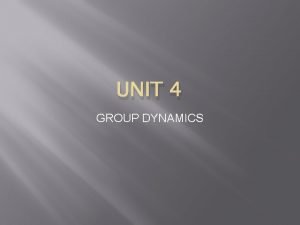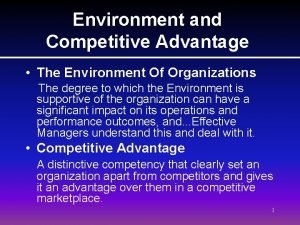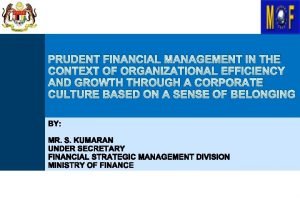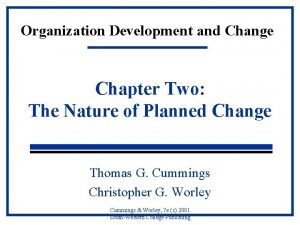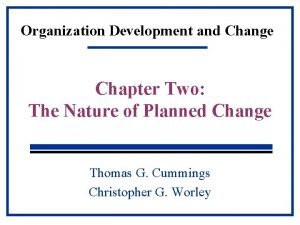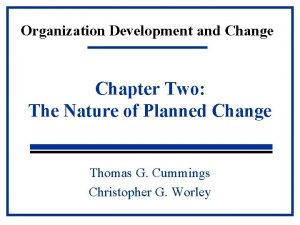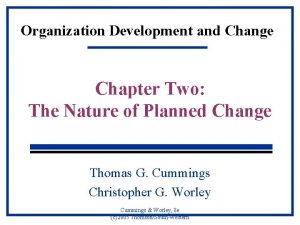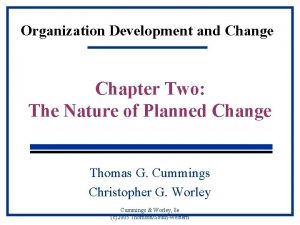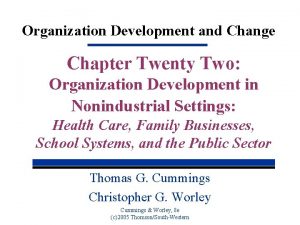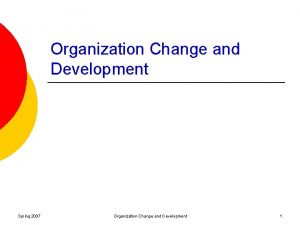Organization Development and Change Chapter Two The Nature









- Slides: 9

Organization Development and Change Chapter Two: The Nature of Planned Change Thomas G. Cummings Christopher G. Worley Cummings & Worley, 8 e (c)2005 Thomson/South-Western

Learning Objectives for Chapter Two • To describe and compare three major perspectives on changing organizations. • To introduce a General Model of Planned Change that will be used to organize the material presented in the book. • To describe how planned change can be adopted to fit different kinds of conditions. Cummings & Worley, 8 e (c)2005 Thomson/South-Western 2

Lewin’s Change Model Unfreezing Movement Refreezing Cummings & Worley, 8 e (c)2005 Thomson/South-Western 3

Action Research Model Problem Identification Consultation with a behavioral scientist Joint diagnosis Joint action planning Data gathering & preliminary diagnosis Feedback to Client Action Data gathering after action Cummings & Worley, 8 e (c)2005 Thomson/South-Western 4

Positive Model Initiate the Inquiry Inquire into Best Practices Discover Themes Envision a Preferred Future Design and Deliver Ways to Create the Future Cummings & Worley, 8 e (c)2005 Thomson/South-Western 5

Comparison of Planned Change Models • Similarities – Change preceded by diagnosis or preparation – Apply behavioral science knowledge – Stress involvement of organization members – Recognize the role of a consultant • Differences – General vs. specific activities – Centrality of consultant role – Problem-solving vs. social constructionism Cummings & Worley, 8 e (c)2005 Thomson/South-Western 6

General Model of Planned Change Entering and Contracting Diagnosing Planning and Implementing Change Cummings & Worley, 8 e (c)2005 Thomson/South-Western Evaluating and Institutionalizing Change 7

Different Types of Planned Change • Magnitude of Change – Incremental – Quantum • Degree of Organization – Overorganized – Underorganized • Domestic vs. International Settings Cummings & Worley, 8 e (c)2005 Thomson/South-Western 8

Critique of Planned Change • Conceptualization of Planned Change – Change in not linear – Change is not rational – The relationship between change and performance is unclear • Practice of Planned Change – Limited consulting skills and focus – Quick fixes vs. development approaches Cummings & Worley, 8 e (c)2005 Thomson/South-Western 9
 Nature and nature's law lay hid in night meaning
Nature and nature's law lay hid in night meaning Alternating pattern essay
Alternating pattern essay Organization change and stress management
Organization change and stress management Nature nature controversy
Nature nature controversy World nature organization logo
World nature organization logo Function of group dynamics
Function of group dynamics Nature of organization
Nature of organization What is nature of organization
What is nature of organization Process organization in computer organization
Process organization in computer organization Prudent practices for organization growth and development
Prudent practices for organization growth and development





